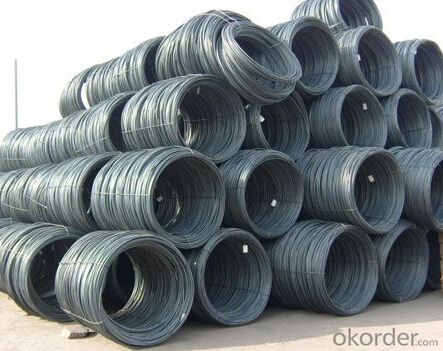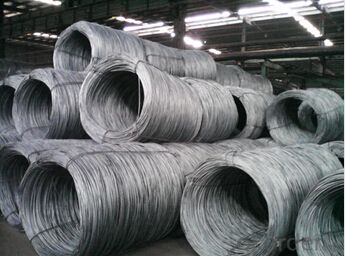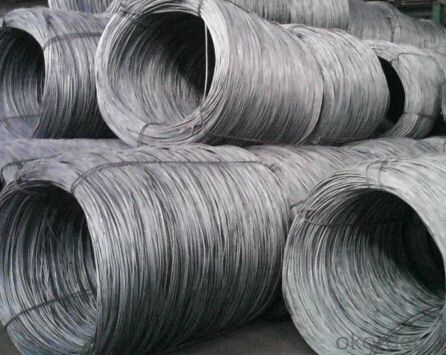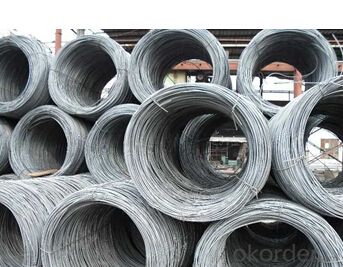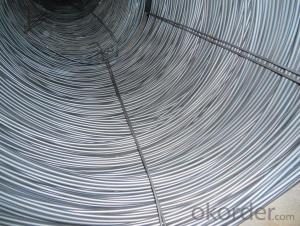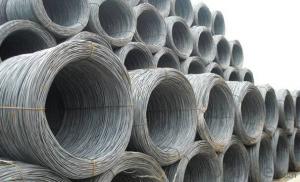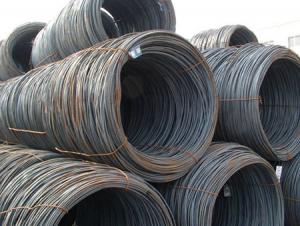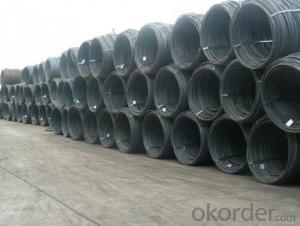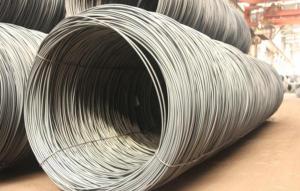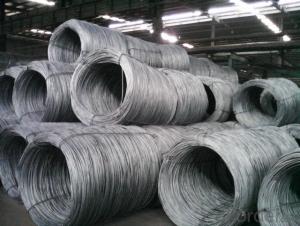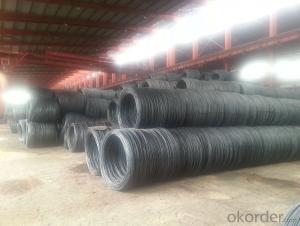Standard ASTM, GB Wire Rod SAE1008B
- Loading Port:
- China Main Port
- Payment Terms:
- TT or LC
- Min Order Qty:
- -
- Supply Capability:
- -
OKorder Service Pledge
OKorder Financial Service
You Might Also Like
Product Description:
OKorder is offering Standard ASTM, GB Wire Rod SAE1008B at great prices with worldwide shipping. Our supplier is a world-class manufacturer of steel, with our products utilized the world over. OKorder annually supplies products to European, North American and Asian markets. We provide quotations within 24 hours of receiving an inquiry and guarantee competitive prices.
Product Applications:
Standard ASTM, GB Wire Rod SAE1008B are ideal for structural applications and are widely used in the construction of buildings and bridges, and the manufacturing, petrochemical, and transportation industries.
Product Advantages:
OKorder's Standard ASTM, GB Wire Rod SAE1008B are durable, strong, and resist corrosion.
Main Product Features:
· Premium quality
· Prompt delivery & seaworthy packing (30 days after receiving deposit)
· Corrosion resistance
· Can be recycled and reused
· Mill test certification
· Professional Service
· Competitive pricing
Specifications of Standard: ASTM, GB Wire Rod SAE1008B:
Steel Grade: SAE1008B Standard: ASTM, GB
Diameter: 5.5mm, 6.5mm, 7mm,8mm,9mm,10mm,12mm,14mm
Type: Drawn Wire Alloy or Not: Alloy Brand Name: N-RIVER
Technique: Hot Rolled Place of Origin: China Mainland
Chemical Composition:
Please kindly find our chemistry of our material based on SAE1008B as below for your information
Grade | Chemical Composition (%) | |||||
C | Mn | S | P | Si | B | |
SAE1008B | 0.10max | 0.32max | 0.045max | 0.040max | 0.30max | 0.0008min |
Mechanical properties | ||||||
Yield strength(N/mm2) | Tensile strength(N/mm2) | Elongation (%) | ||||
≥195 | 350-380 | ≥32 | ||||
Usage and Applications of Wire Rod SAE1008B:
After hot-rolled the products shaped into coil and delivery as finished product, including round, square, rectangular, hexagonal and so on. Since most of the products are round, it is generally called wire rod. Carbon steel wire rod is widely used in construction and manufacturing. Carbon steel wire rod is mainly used for reinforcement of reinforced concrete and welded structure or reprocessed (roberts , nail, etc.) materials, especially used to produce wire drawing, welding electrode, nails, spring, electronic, precise machinery parts and so on.
Production Process of Wire Rod SAE1008B:
1-Furnace 2-Roughing Mill 3-High-speed Finishing Mill 4-Water-cooled Device 5-Coiling Device
6-Cooling Device 7-Chain Conveyer 8-Spool Collecting Device 9-Spool Down Device 10-Hook Conveyer
Packaging & Delivery of Wire Rod SAE1008B:
Packaging Detail: products are packed in coil and then shipped by container or bulk vessel
Each coil weight: 2-3MT
Delivery Detail: within 45 days after received deposit or LC.
Label: to be specified by customer, generally, each bundle has 1-2 labels
Trade terms: CFR, CIF
Wire Rod in Container
Wire Rod in Bulk Vessel
Note:
1. Our products are produced according to national standard (GB), if not, supply according to national standards (GB) or agreement as customer required.
2. Other Grade and Standard carbon steel wire rod we can supply:
Grade: H08A, 30MnSi, 62B-82B
Standard: AISI, BS, JIS, DIN
The Minimum Order Quantity of these products is high, and need to be confirmed.
3. We can not only supply carbon steel wire rod; if you need anything about building materials, please contact us.
4. Please send us your detail specifications when inquire. We will reply to you as soon as possible. We sincerely hope we can establish a long stable business relationship.
FAQ:
Q1: Why buy Materials & Equipment from OKorder.com?
A1: All products offered byOKorder.com are carefully selected from China's most reliable manufacturing enterprises. Through its ISO certifications, OKorder.com adheres to the highest standards and a commitment to supply chain safety and customer satisfaction.
Q2: How soon can we receive the product after purchase?
A2: Within three days of placing an order, we will begin production. The specific shipping date is dependent upon international and government factors, but is typically 7 to 10 workdays.
Q3: What makes stainless steel stainless?
A3: Stainless steel must contain at least 10.5 % chromium. It is this element that reacts with the oxygen in the air to form a complex chrome-oxide surface layer that is invisible but strong enough to prevent further oxygen from "staining" (rusting) the surface. Higher levels of chromium and the addition of other alloying elements such as nickel and molybdenum enhance this surface layer and improve the corrosion resistance of the stainless material.
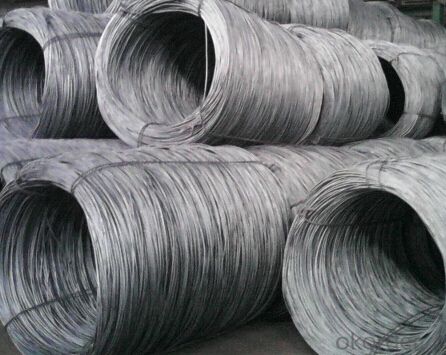
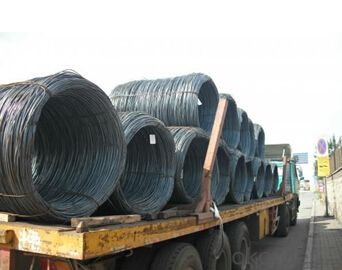
- Q: How does the price of steel wire rod fluctuate in the market?
- The price of steel wire rod fluctuates in the market due to a variety of factors. One significant factor is the supply and demand dynamics within the steel industry. When there is a high demand for steel wire rod, such as during periods of economic growth or construction booms, the price tends to increase. Conversely, when there is a decrease in demand or oversupply of steel wire rod, the price tends to decrease. Another factor that affects the price of steel wire rod is the cost of raw materials. Steel wire rod is typically made from iron ore, which is subject to price fluctuations in the global market. If the cost of iron ore increases, it can lead to higher production costs for steel manufacturers, resulting in higher prices for steel wire rod. Additionally, fluctuations in energy prices can impact the price of steel wire rod. Steel production requires a significant amount of energy, particularly in the form of electricity and natural gas. If energy prices rise, it can increase the cost of production, leading to higher prices for steel wire rod. Furthermore, changes in trade policies and tariffs can also influence the price of steel wire rod. Governments may impose tariffs or trade restrictions on steel imports, which can restrict the supply of steel wire rod in the market and potentially raise prices. Lastly, market speculation and investor sentiment can also contribute to price fluctuations in the steel wire rod market. Investors and traders may anticipate future changes in supply and demand or react to economic indicators, resulting in volatile price movements. Overall, the price of steel wire rod is subject to a range of factors including supply and demand dynamics, raw material costs, energy prices, trade policies, and market speculation. These factors can cause the price to fluctuate in response to changes in the broader economy and industry conditions.
- Q: What are the main challenges in the steel wire rod industry?
- The operations and growth of the steel wire rod industry are impacted by several main challenges. To begin with, the volatility of raw material prices is one of the primary challenges. The industry heavily relies on inputs like iron ore and coal, and fluctuations in their prices can greatly affect profitability. This makes it challenging for companies to plan and forecast production costs. Additionally, intense competition is a struggle for the industry, both domestically and internationally. Many countries have a well-established steel wire rod industry, leading to oversupply and price wars. Manufacturers are under pressure to enhance production efficiency and reduce costs to stay competitive. Furthermore, environmental regulations and sustainability concerns pose another significant challenge. Steel wire rod production is energy-intensive and can result in emission of greenhouse gases and pollutants. Compliance with regulations and adoption of sustainable practices can add extra costs, requiring investments in new technologies and equipment. Moreover, meeting changing customer demands and preferences is a challenge for the industry. Customers now desire higher quality and customized steel wire rods that meet specific technical requirements. Manufacturers need to invest in research and development to develop new products and processes to meet these evolving needs. Additionally, the industry faces logistical challenges due to the heaviness and bulkiness of its products. Transportation costs can be high, especially for long-distance shipments, which impacts the competitiveness of manufacturers. Furthermore, the industry relies on a complex supply chain, and any disruptions or delays in the delivery of raw materials or finished products can have significant consequences for production schedules and customer satisfaction. Lastly, the steel wire rod industry is also vulnerable to economic cycles and global economic conditions. Slowdowns in construction and infrastructure projects, major consumers of steel wire rods, can lead to reduced demand and excess inventory. Economic downturns or trade disputes can also impact the industry's growth prospects and profitability. In conclusion, the steel wire rod industry faces various challenges, including volatile raw material prices, intense competition, environmental regulations, changing customer demands, logistical challenges, and economic fluctuations. Overcoming these challenges requires continuous innovation, improved efficiency, and adaptation to changing market conditions.
- Q: What are the main uses of steel wire rod?
- Steel wire rod is primarily used in the construction industry for various applications such as reinforcing concrete structures, manufacturing wire mesh, and producing steel cables and wires. It is also used in the automotive industry for making springs, suspension systems, and other components that require high-strength materials. Additionally, steel wire rod finds utility in the manufacturing of nails, screws, and other fasteners, as well as in the production of electrical wires and cables.
- Q: How is steel wire rod used in the manufacturing of wire for automotive seatbelts?
- Steel wire rod, known for its strength and durability, is a crucial element in the production of automotive seatbelt wire. The manufacturing process begins with carefully selecting steel wire rods based on their mechanical properties and chemical composition. These rods are made from high-quality steel alloys that are specifically chosen for their ability to withstand high tension and provide reliable performance in critical safety applications. The selected steel wire rods are then subjected to a series of manufacturing steps. Firstly, they are heated to high temperatures and hot rolled into thin strips. This process not only refines the grain structure of the steel, enhancing its strength and toughness, but also reduces the thickness of the wire rod, making it suitable for the subsequent wire drawing process. After hot rolling, the wire rods go through a wire drawing machine. This machine gradually reduces their diameter while increasing their length, imparting the desired mechanical properties such as improved tensile strength and flexibility. Once the wire drawing process is completed, the resulting wires undergo various quality control tests to ensure they meet the required specifications for automotive seatbelt manufacturing. These tests include checking for proper tensile strength, elongation, and uniformity of the wire. To enhance their corrosion resistance and long-term durability, the wires are coated with a protective layer such as zinc or a polymer. This coating also improves their ability to withstand harsh environmental conditions. The finished wire is then used by automotive seatbelt manufacturers to create the intricate webbing pattern that forms the seatbelt. The strength and reliability of the steel wire rod are crucial in ensuring the seatbelt can withstand the forces exerted during sudden stops or impacts, providing occupants with a high level of safety protection. In conclusion, steel wire rod is an indispensable material in the manufacturing of wire for automotive seatbelts. Its high tensile strength, durability, and ability to withstand extreme conditions make it the ideal choice for this critical safety component.
- Q: What are the specifications for steel wire rod?
- The specifications for steel wire rod can vary depending on the specific application and industry requirements. However, some common specifications include the diameter range, tensile strength, chemical composition, surface finish, and tolerance levels. These specifications ensure the desired strength, durability, and quality of the steel wire rod for its intended use in various industries such as construction, automotive, and manufacturing.
- Q: What are the different surface protection materials used for steel wire rod?
- Steel wire rods can be protected using various surface protection materials. These materials are applied to the wire rod's surface to prevent corrosion and other forms of damage. One commonly used surface protection material for steel wire rods is zinc coating. This involves immersing the wire rod in a hot-dip galvanizing process, which results in a layer of zinc on its surface. Zinc acts as a highly effective corrosion inhibitor and creates a protective barrier between the steel and its environment. This coating is typically used for wire rods that will be exposed to harsh or corrosive conditions. Polymer coating is another surface protection material for steel wire rods. It can be applied using different methods like extrusion or dip coating. These coatings serve as a barrier against moisture, chemicals, and abrasion, effectively preventing corrosion and prolonging the wire rod's lifespan. Polymer coatings are commonly used for wire rods in indoor or outdoor applications that require corrosion resistance. Phosphate coating is a surface protection material that involves immersing the wire rod in a phosphate solution, resulting in a thin phosphate layer on its surface. This coating enhances adhesion for subsequent coatings or paints and offers some corrosion resistance. It is often used as a pre-treatment before applying other surface protection materials. Lastly, epoxy coating is a widely used surface protection material for steel wire rods. It is typically applied through electrostatic spray deposition. Epoxy coatings provide excellent corrosion resistance, chemical resistance, and durability. They are commonly used for wire rods exposed to harsh environments like marine or industrial applications. In conclusion, various surface protection materials, including zinc coating, polymer coating, phosphate coating, and epoxy coating, can be applied to steel wire rods. The selection of these materials depends on the specific requirements of the wire rod and its intended application.
- Q: How is steel wire rod straightened after the rolling process?
- Steel wire rod, after the rolling process, typically does not have a perfect straightness. To rectify this, there are multiple methods that can be utilized. One commonly used method is known as the straightening process, which includes passing the wire rod through a sequence of straightening rolls or dies. The initial set of rolls, through which the wire rod is fed, is usually inclined at an angle. As the rod passes through these rolls, it is bent in the opposite direction of its original curvature. The angle of the rolls is adjusted accordingly to gradually straighten the rod. This process is repeated with multiple sets of rolls, each set slightly altering the angle to further straighten the wire rod. Another method employed for straightening steel wire rod is the rotary straightening process. In this method, the wire rod is guided through a series of rotating straightening rolls. These rolls are often positioned at various angles to effectively straighten the rod. As the rod moves through the rolls, it undergoes bending forces that counteract its initial curvature, resulting in a straightened wire rod. Furthermore, there exist specialized machines and equipment designed specifically for straightening steel wire rod. These machines employ different mechanisms, such as hydraulic or mechanical systems, to apply controlled bending forces to the rod and straighten it. Overall, the process of straightening steel wire rod involves the application of controlled bending forces through sets of rolls or specialized machines. This gradual process serves to eliminate any curvature, resulting in a straightened wire rod that meets the necessary specifications.
- Q: What are the common applications of high-strength steel wire rod?
- High-strength steel wire rods have a wide range of applications across various industries due to their exceptional strength and durability. Some of the common applications of high-strength steel wire rods include: 1. Automotive industry: High-strength steel wire rods are extensively used in the automotive industry for manufacturing various components such as springs, suspension systems, seat frames, and reinforcement bars. The high tensile strength of these wire rods ensures enhanced safety and stability in vehicles. 2. Construction industry: Steel wire rods find extensive use in the construction industry for reinforcement purposes. They are commonly used to strengthen concrete structures such as bridges, buildings, and highways. The high strength and ductility of these wire rods make them ideal for withstanding heavy loads and seismic forces. 3. Manufacturing industry: High-strength steel wire rods are widely used in the manufacturing industry for producing a variety of products, including cables, wire mesh, nails, screws, and fasteners. The superior strength and durability of these wire rods make them suitable for applications that require resistance to bending, twisting, and tension. 4. Aerospace industry: High-strength steel wire rods find applications in the aerospace industry for manufacturing aircraft components. They are used in the production of cables, control systems, landing gear, and engine components. The high strength-to-weight ratio of these wire rods plays a crucial role in ensuring the safety and reliability of aircraft structures. 5. Energy sector: Steel wire rods are commonly used in the energy sector for various applications. They are utilized in power transmission lines, suspension cables for bridges and power plants, and wire ropes for lifting heavy equipment. The high tensile strength and corrosion resistance of these wire rods make them suitable for withstanding the demanding conditions of the energy sector. 6. Consumer goods: High-strength steel wire rods are also used in the manufacturing of consumer goods such as furniture, appliances, and sporting equipment. They are employed in the production of springs for mattresses and chairs, wire frames for household appliances, and components for fitness equipment. The durability and reliability of these wire rods contribute to the longevity of consumer products. Overall, the common applications of high-strength steel wire rods span across industries, including automotive, construction, manufacturing, aerospace, energy, and consumer goods. Their exceptional strength, durability, and versatility make them a preferred choice for various applications where reliability and performance are crucial factors.
- Q: How is steel wire rod used in the manufacturing of wire for thermal insulation?
- Steel wire rod is an essential component in the manufacturing process of wire for thermal insulation. It is used as the raw material for producing the wire that forms the foundation of thermal insulation products. The process begins with steel wire rod being fed into a wire drawing machine. This machine reduces the diameter of the wire rod through a series of dies, resulting in finer and thinner wire. The drawn wire is then further processed to achieve the desired diameter and strength required for thermal insulation applications. Once the wire has been drawn to the required specifications, it is coated with a specialized insulation material. This insulation material could be a polymer, rubber, or other thermally insulating substance. The coating process ensures that the wire is adequately protected and provides enhanced thermal insulation properties. The coated wire is then wound into coils or spools, ready to be used in various thermal insulation applications. It is commonly utilized in products such as heating cables, resistance wires, or as a reinforcement component in thermal insulation materials. The steel wire rod used in the manufacturing of wire for thermal insulation is chosen for its strength, durability, and ability to withstand high temperatures. It provides the necessary structural integrity to maintain the shape and effectiveness of the insulation product. In summary, steel wire rod is a crucial element in the production of wire for thermal insulation. It undergoes various processing steps, including wire drawing and coating, to create a high-quality product that offers excellent thermal insulation properties.
- Q: What are the different types of steel wire rod coatings used for enhanced wear resistance?
- There are several different types of steel wire rod coatings that are commonly used to enhance wear resistance. These coatings are applied to the surface of the steel wire rod to provide a protective layer that improves the longevity and durability of the wire. One type of coating used for enhanced wear resistance is zinc. Zinc coating, also known as galvanizing, involves immersing the steel wire rod in a bath of molten zinc. This process creates a layer of zinc on the surface of the wire, which acts as a barrier against corrosion and wear. Zinc coatings are commonly used in applications where the wire will be exposed to harsh environments or high levels of moisture. Another type of coating used for wear resistance is polymer. Polymer coatings are typically applied as a thin layer on the surface of the steel wire rod. These coatings provide a protective barrier against abrasion, chemicals, and other forms of wear. Polymer coatings can be customized to provide specific properties such as high temperature resistance, low friction, or resistance to specific chemicals, making them suitable for a wide range of applications. Additionally, ceramic coatings are also used to enhance wear resistance in steel wire rods. Ceramic coatings are typically applied using a chemical or physical vapor deposition process. These coatings create a thin layer of ceramic material on the surface of the wire rod, which offers excellent resistance to wear, corrosion, and high temperatures. Ceramic coatings are commonly used in applications where the wire will be subjected to extreme conditions or high levels of friction. In conclusion, there are various types of steel wire rod coatings used to enhance wear resistance. Zinc coatings provide corrosion protection, polymer coatings offer resistance to abrasion and chemicals, and ceramic coatings provide excellent resistance to wear, corrosion, and high temperatures. The choice of coating depends on the specific application and the desired level of wear resistance required.
Send your message to us
Standard ASTM, GB Wire Rod SAE1008B
- Loading Port:
- China Main Port
- Payment Terms:
- TT or LC
- Min Order Qty:
- -
- Supply Capability:
- -
OKorder Service Pledge
OKorder Financial Service
Similar products
Hot products
Hot Searches
Related keywords




